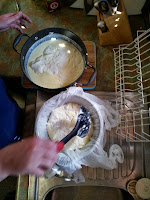Writer: Alex
Participants: Alex, Clare
Items: Milk, Flax as Linen,
Honeycomb as Honey
There are a number of
recipes for quark. This one comes from the Ricki Carroll, Home Cheese Making
Book and is very similar to other recipes I have seen.
Quark is a soft, unrenneted
cheese. It is also believed to be the oldest form of cheese in Europe [Carroll,
Kindstedt]. There are different types of quark, Sahnequark or Cream Quark (made
with heavy cream and milk in a 1:4 ratio), Quark (made with whole milk) and
Magerquark or Schichtkase (made with low fat milk). [Carroll].
Quark is possibly described by Tacitus in his book Germania as lac
concretum (thick milk), eaten by Germanic peoples.
(23)
Potui umor ex hordeo aut frumento, in quandam similitudinem vini corruptus:
proximi ripae et vinum mercantur. Cibi simplices, agrestia poma, recens fera aut
lac concretum: sine apparatu, sine blandimentis expellunt famem. Adversus sitim
non eadem temperantia. Si indulseris ebrietati suggerendo quantum concupiscunt,
haud minus facile vitiis quam armis vincentur.
Google Translate
I could have moisture of barley or other grain,
into a certain resemblance to wine: neighbor's banks, and buy wine. Their food
is simple, wild fruit, fresh milk, or a wild beast of the concrete without
elaborate preparation and without delicacies drive out hunger. Quenching their
thirst not equally moderate. If you indulge their drinking by supplying them as
much as they desire, they were quite as easy to vices than by arms is superior.
|
Equipment
Large pot or water bath
Slotted spoon
Cheese thermometer
Colander
Fine muslin cheese cloth
(or linen)
large bowl
|
Ingredients
3Lt pasteurised,
unhomogenised cows milk
1 packet of direct set buttermilk starter
(Mesophilic)
|
Method
- slowly heat milk to 31oC (around 30mins)
- add starter culture and stir slowly from top to bottom for 1 minute
- cover and leave to ripen at room temperature for 24hours
- line your colander with the muslin
- gently scoop the curd into the muslin using a slotted spoon
- tie the corners of the muslin together
- place the colander in a bowl in the fridge to drain overnight (16hours)
- if desired, put a sealed container filled with water on top of the curd bag to aid draining
- once drained, remove from muslin and place in a bowl for up to 2weeks
- if the mix is dry, add a couple of tablespoons of cream and stir.
Preparing to wrap it for draining.
After pressing in the fridge for 2 days.
Final product!
Our final product at the Pentathlon judging session.
Notes
- For the starter culture I did some research regarding what bacteria was required as I'd never heard of buttermilk starter. Mad Millie Flora Danca starter contained the bacteria this recipe calls for and that is what I used.
- I let the mix drain for 2 days rather than the 1 it says as the mix still had a lot of whey forming at the end of day 1.
- I wrapped the pot I was using in two towels to help keep the warmth overnight as it matured. I am not sure if this helped or hindered in any way.
- The mix did not require the additional cream.
- The end product is quite tart, much closer to a sour cream than what we would consider a cheese. It would be lovely as a dip for fresh vegetables!
- This recipe is a little odd compared to the others I have tried. Because you use no rennet the curd does not set the same way and you cannot cut it, it’s too liquid. This made scooping it into the muslin almost unnecessary as you can pour it, though it is very thick.
- There are many references to adding herbs and other flavours to quark as it is drained. Towards this end, I will be providing a sample of the more common flavoured quark suggestions at presentation (plain, cream sweetened, chives, thyme and continental parsley, and mixed with honey).






